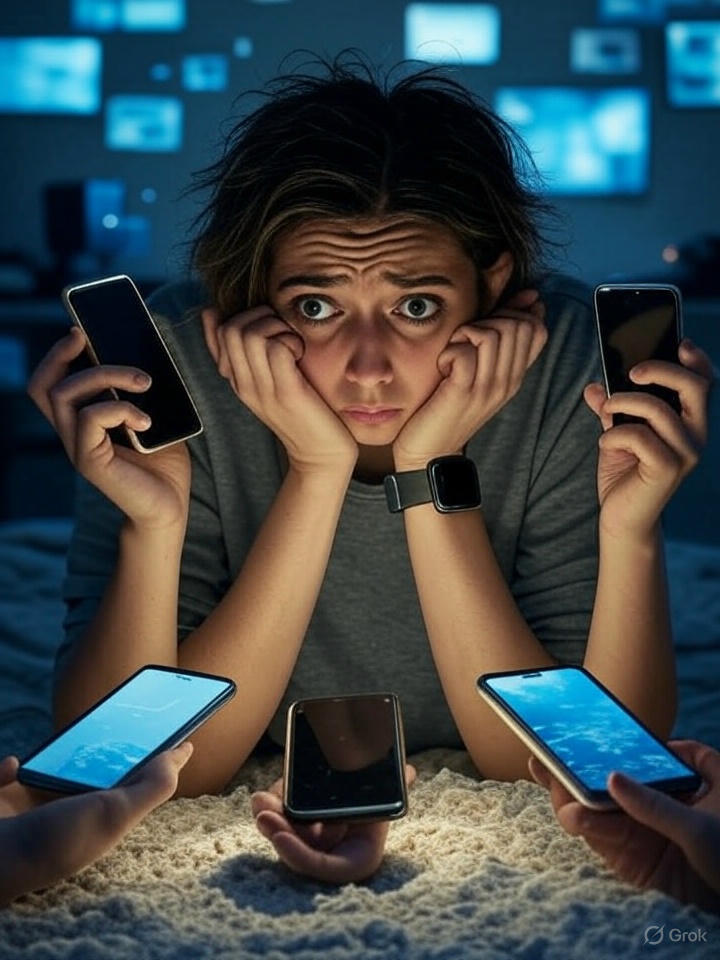The constant ping of notifications has become a soundtrack to our lives. From emails and social media alerts to app updates and text messages, our devices are always vying for our attention. But what happens when that endless stream of notifications starts to feel overwhelming? Enter notification anxiety, a growing phenomenon that’s reshaping how we interact with technology and each other. This article explores the psychology behind notification anxiety, why it’s spiking in 2025, and how you can manage it to reclaim your mental peace.

What is Notification Anxiety?
Notification anxiety refers to the stress, unease, or compulsive behavior triggered by the constant influx of digital alerts. It’s that sinking feeling when your phone vibrates for the tenth time in an hour, or the urge to check every red badge on your apps, even when you’re in the middle of something important. According to a 2024 study by the American Psychological Association, 68% of adults report feeling stressed by notifications at least occasionally, with younger generations like Gen Z and Millennials reporting higher rates due to their heavy smartphone use.
This anxiety isn’t just about annoyance—it’s rooted in how our brains process these digital interruptions. Notifications tap into our innate desire for novelty and social connection, but they also overload our cognitive systems, leading to mental fatigue and reduced productivity.
Why Notifications Stress Us Out
Our brains are wired to respond to new stimuli, a trait that helped our ancestors survive by staying alert to potential threats or opportunities. Notifications exploit this instinct, creating a dopamine-driven feedback loop. Each alert promises a reward—maybe it’s a like on your latest post or an urgent work email—but it also pulls us away from the present moment. Here’s why this cycle is so taxing:
- Fear of Missing Out (FOMO): Notifications feed into FOMO, making us feel like we’ll miss something critical if we don’t check immediately. A 2023 study from the Journal of Social Psychology found that FOMO is a significant driver of compulsive phone-checking, with 54% of participants admitting they check their devices within minutes of a notification.
- Cognitive Overload: Constant interruptions fragment our attention, making it harder to focus. Research from Stanford University in 2024 showed that frequent notifications reduce task performance by up to 20%, as our brains struggle to switch between tasks efficiently.
- Social Pressure: Many notifications come from social apps, where the expectation to respond quickly adds a layer of social obligation. This can feel like a never-ending to-do list, especially for those who rely on digital communication for work or relationships.
The Rise of Notification Anxiety in 2025
Notification anxiety is surging as our reliance on technology deepens. Several emerging trends are making this issue more prevalent:
- AI-Driven Notifications: With AI becoming more integrated into apps, notifications are getting smarter—and more intrusive. AI algorithms now predict when you’re most likely to engage, sending tailored alerts at just the right (or wrong) moment. For example, social media platforms use AI to push notifications when you’re likely to be bored, amplifying the urge to check.
- Wearable Tech Overload: Smartwatches and other wearables have made notifications even harder to escape. A 2025 report from TechCrunch noted a 30% increase in wearable device usage, with many users reporting that wrist buzzes feel more urgent than phone pings, heightening anxiety.
- Work-from-Anywhere Culture: The shift to remote and hybrid work has blurred the lines between personal and professional life. Tools like Slack and Microsoft Teams send a barrage of notifications, making it feel impossible to disconnect. A 2024 survey by Gallup found that 45% of remote workers feel pressured to respond to work notifications outside regular hours.
The Psychological Toll of Constant Alerts
The impact of notification anxiety goes beyond momentary frustration. Over time, it can take a serious toll on mental health:
- Increased Stress and Burnout: Chronic exposure to notifications elevates cortisol levels, the body’s stress hormone. Over time, this can contribute to burnout, especially for those who feel tethered to their devices.
- Impaired Relationships: Constantly checking notifications during conversations can strain relationships. A 2024 study from the University of Cambridge found that “phubbing” (phone snubbing) reduces relationship satisfaction by 15% among couples.
- Sleep Disruption: Notifications, especially at night, interfere with sleep quality. The blue light from screens and the mental stimulation from checking alerts can delay melatonin production, making it harder to fall asleep.
Strategies to Manage Notification Anxiety
The good news? You can take control of notification anxiety with practical, science-backed strategies. Here’s how to tame the notification beast and reclaim your mental calm:
- Audit Your Notifications
Start by reviewing which apps are sending you notifications. Go through your phone’s settings and disable non-essential alerts. For example, do you really need to know every time someone likes your post? Prioritize notifications from critical apps like messaging or work tools. - Set Boundaries with Do Not Disturb
Use your phone’s Do Not Disturb mode to silence notifications during specific hours, like during meals, work focus time, or at night. You can customize it to allow calls or messages from key contacts while muting everything else. - Batch Your Checks
Instead of reacting to every ping, set specific times to check your phone—say, every hour or two. This reduces the mental cost of task-switching and helps you stay focused. Apps like Freedom or Forest can help enforce this habit. - Curate Your Apps
Be ruthless about which apps you keep. If an app’s notifications are more annoying than useful, consider deleting it or turning off its alerts entirely. A 2024 study from the University of Cambridge suggests that reducing app clutter can lower stress by 10%. - Practice Mindful Engagement
Before checking a notification, pause and ask yourself if it’s urgent. This small habit can break the compulsive checking cycle and help you stay present. Mindfulness apps like Headspace offer exercises to build this skill. - Use Grayscale Mode
Switching your phone to grayscale can make notifications less enticing, as the lack of color reduces the dopamine hit from colorful app icons. Many users report a 25% drop in compulsive checking after making this switch, per a 2025 TechCrunch survey. - Schedule Tech-Free Time
Designate tech-free zones in your day—like during meals or the first hour after waking up. This creates space for uninterrupted focus and relaxation, reducing the mental load of constant connectivity.
How to Implement These Changes Without Stress
Transitioning to a notification-light lifestyle doesn’t have to feel overwhelming. Here’s a step-by-step plan to ease into it:
- Day 1-2: Audit and Prioritize
Spend a day tracking which notifications you receive and categorize them as “essential” or “optional.” Turn off all optional ones. - Day 3-5: Test Boundaries
Experiment with Do Not Disturb for a few hours each day. Start with low-stakes times, like during a hobby or commute, and note how it feels to be uninterrupted. - Week 2: Refine and Reflect
After a week, assess which changes made the biggest difference. Adjust your settings further—maybe mute group chats or turn off badge icons for certain apps. - Ongoing: Build Habits
Use reminders or calendar blocks to check notifications at set times. Pair this with mindfulness practices to stay intentional about your tech use.
The Bigger Picture: Reclaiming Your Attention
Notification anxiety is more than just a personal quirk—it’s a symptom of a broader cultural shift toward constant connectivity. By understanding the psychology behind it, you can take deliberate steps to protect your mental energy. The goal isn’t to ditch technology entirely but to use it on your terms, not the other way around.
In 2025, as AI and wearables make notifications even more pervasive, these strategies are more crucial than ever. By setting boundaries and curating your digital environment, you can reduce stress, improve focus, and create space for what truly matters—whether that’s deep work, meaningful relationships, or simply a moment of quiet.
Sources:
1. Elhai, J. D., Levine, J. C., & Hall, B. J. (2018). Fear of Missing Out as a Mediator Between Anxiety and Problematic Smartphone Use. Current Psychology.
https://www.researchgate.net/publication/333874710_Disrupted_Daily_Activities_From_Interruptive_Smartphone_Notifications_Relations_With_Depression_and_Anxiety_Severity_and_the_Mediating_Role_of_Boredom_Proneness capsulenz.comresearchgate.net
2. Pielot, M., & Rello, L. (2016). Productive, Anxious, Lonely – 24 Hours Without Push Notifications. arXiv.
https://arxiv.org/abs/1612.02314 arxiv.org+1arxiv.org+1
3. Oaten, J. (2023). What Notifications Are Doing To Our Brains. Discover Magazine.
https://santamaria.wa.edu.au/notifications-and-our-brains/






